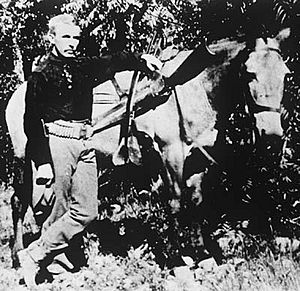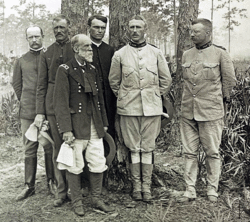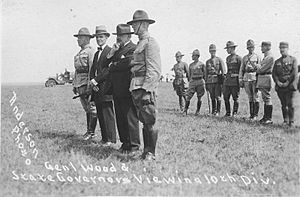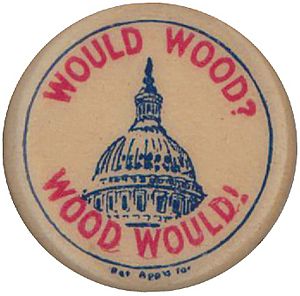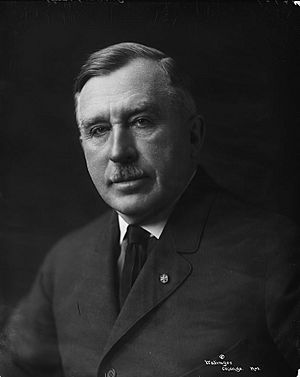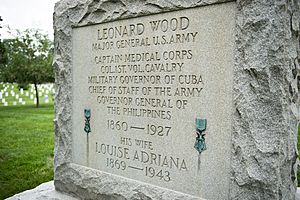Leonard Wood facts for kids
Quick facts for kids
Leonard Wood
|
|
|---|---|
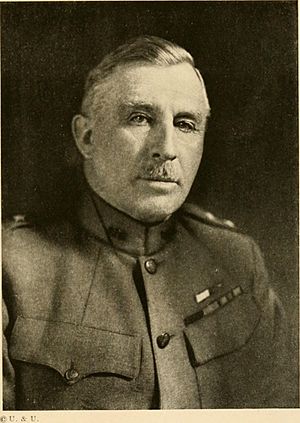
Wood, c. 1920
|
|
| Governor-General of the Philippines | |
| In office October 14, 1921 – August 7, 1927 |
|
| President | Warren G. Harding Calvin Coolidge |
| Preceded by | Charles Yeater |
| Succeeded by | Eugene A. Gilmore |
| Chief of Staff of the United States Army | |
| In office April 22, 1910 – April 21, 1914 |
|
| Preceded by | Franklin Bell |
| Succeeded by | William W. Wotherspoon |
| Governor of Moro Province | |
| In office July 25, 1903 – April 16, 1906 |
|
| Preceded by | Position established |
| Succeeded by | Tasker H. Bliss |
| Governor-General of Cuba | |
| In office December 23, 1899 – May 20, 1902 |
|
| Preceded by | John R. Brooke |
| Succeeded by | Tomás Estrada Palma (President) |
| Personal details | |
| Born | October 9, 1860 Winchester, New Hampshire |
| Died | August 7, 1927 (aged 66) Boston, Massachusetts |
| Resting place | Arlington National Cemetery |
| Political party | Republican |
| Spouse |
Louise Condit Smith
(m. 1890) |
| Children | 3 |
| Military career | |
| Allegiance | United States |
| Service/ |
United States Army |
| Years of service | 1886–1921 |
| Rank | Major General |
| Service number | 0-2 |
| Unit | United States Army Medical Corps |
| Commands held | Chief of Staff of the United States Army Sixth Corps Area 10th Division 89th Division Southern Department Department of the East Philippines Division 1st United States Volunteer Cavalry |
| Battles/wars | Apache Wars Spanish–American War Philippine–American War World War I |
| Awards | Medal of Honor Army Distinguished Service Medal |
| Signature | |
| Education | Harvard University (MD, 1884) |
Leonard Wood (born October 9, 1860 – died August 7, 1927) was an important American figure. He was a doctor, a U.S. Army major general, and a public official. He served as the top leader of the U.S. Army, known as the Chief of Staff of the United States Army. He also governed Cuba and the Philippines.
Wood started his military life as an army doctor. He earned the Medal of Honor for his bravery. During the Spanish–American War, he led a famous group of soldiers called the Rough Riders. Theodore Roosevelt was his second-in-command. Later, Wood became a well-known leader in the Republican Party. He was a top choice for president in 1920.
Born in Winchester, New Hampshire, Wood studied at Harvard Medical School to become a doctor. He joined the army as a surgeon. He received the Medal of Honor for his actions in the Apache Wars. He even became the personal doctor for the President of the United States. After the Spanish-American War, Wood helped improve health in Cuba as its military governor. In 1910, he became the Army Chief of Staff. He retired from the army in 1921 and became the Governor-General of the Philippines until he died in 1927.
Contents
Early Life and Education
Leonard Wood was born in Winchester, New Hampshire, on October 9, 1860. He was one of three children. His family had English roots. He grew up in Pocasset, Massachusetts. He was taught by a private teacher. He then went to Pierce Academy.
Wood wanted to join the United States Naval Academy but did not get in. He thought about going on an Arctic trip or becoming a fisherman. After his father and sister died, his mother supported the family. Wood moved away to continue his education. A kind businessman, H. H. Hunnewell, helped him. Hunnewell paid for Wood to attend Harvard Medical School. Wood worked hard and earned a scholarship.
In 1884, Wood became a doctor. He worked at Boston City Hospital. He later opened his own medical office. But business was slow. In 1885, he took exams to join the Army Medical Corps. He wanted a steady job and salary. He did very well on the exams.
Starting His Military Career
In June 1885, Wood began working for the U.S. Army as an assistant surgeon. He was sent to Arizona. In January 1886, he was officially made a first lieutenant in the U.S. Army. He was stationed with the 4th Cavalry at Fort Huachuca, Arizona. Wood took part in the final campaign against Geronimo in 1886. Geronimo was a famous Apache leader.
Medal of Honor for Bravery
In 1898, Wood received the Medal of Honor. This is the highest award for bravery in the U.S. military. He earned it for his actions during the 1886 Geronimo campaign. He carried important messages 100 miles through dangerous land. He also led a group of soldiers whose officers had been killed.
His commanders, Nelson A. Miles and Henry Ware Lawton, strongly recommended him for the medal. They worked for 12 years to make sure he received it.
Medal of Honor Citation: Assistant Surgeon Leonard Wood was honored for his great bravery in the summer of 1886. He volunteered to carry messages through land full of hostile Native Americans. He traveled 70 miles in one night and walked 30 miles the next day. For several weeks, he also led a group of soldiers who had no officer. He asked to lead them while chasing Geronimo's group.
Awarded for Actions During: Indian Campaigns Service: Army Unit: 4th U.S. Cavalry Date of Issue: April 8, 1898.
After his appointment was confirmed, Wood became a first lieutenant. He served at several forts in Arizona and New Mexico. In 1889, he moved to the Presidio of San Francisco. He was promoted to captain in 1891.
Football Coach at Georgia Tech
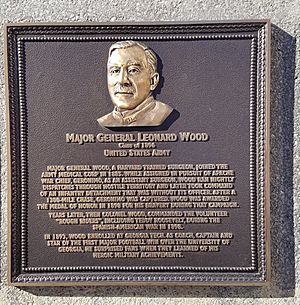
While stationed in Atlanta, Wood went to graduate school at Georgia Tech. He did this so he could play on the school's football team. He organized the 1893 team. He was both the coach and a player. Wood led Georgia Tech to a good record that year. They even beat the University of Georgia 28–6.
Spanish-American War and Beyond
Before the war, Wood was the personal doctor for Presidents Grover Cleveland and William McKinley. During this time, he became good friends with Theodore Roosevelt. Roosevelt was then Assistant Secretary of the Navy.
When the Spanish–American War began, Wood and Roosevelt formed the 1st Volunteer Cavalry Regiment. This group was famously known as the Rough Riders. Wood successfully led the regiment in the Battle of Las Guasimas. He was promoted to brigadier general during the war. He then led a brigade that included the Rough Riders. They won a famous victory at Kettle Hill and San Juan Heights in 1898.
After the war, Wood stayed in Cuba. He became the military governor of Santiago in 1898. Then he served as governor of Cuba from 1899 to 1902. He used his medical knowledge to improve health and sanitation. He also made many reforms, like improving schools and courts. He was promoted to brigadier general in the regular army. In 1902, he ordered that Chinese immigrants could not enter Cuba.
In 1903, Wood went to the Philippines. He was governor of Moro Province until 1906. Then he commanded the Philippine Division until 1908. He was promoted to major general in 1903. Some people in the U.S. Senate thought he was promoted too quickly. He also received some criticism for how he handled the 1906 First Battle of Bud Dajo.
Leading the Army
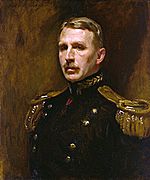
In 1910, President William Howard Taft made Wood the Army Chief of Staff. Wood was the only medical officer ever to hold this top position. As Chief of Staff, Wood started several important programs. One was the early version of the Reserve Officers' Training Corps (ROTC). This program trains college students to become military officers. He also pushed for the Preparedness Movement. This was a campaign to prepare the U.S. military for possible wars. This movement helped create the Selective Service System before World War I.
Wood also reorganized the army's main staff. He divided it into three parts: Mobile Army, Coast Artillery, and War College. This helped the army plan and make decisions better. It prepared the army for when the U.S. would enter World War I.
World War I and After
In 1914, Wood finished his term as Chief of Staff. He then commanded the army's Eastern Department. Wood strongly supported the Preparedness Movement. This movement was led by Republicans. This caused some disagreement with President Woodrow Wilson, who wanted the U.S. to stay out of wars. Wood gave speeches and wrote articles to support military readiness.
When the U.S. was about to enter World War I in 1917, many thought Wood would lead American forces in France. However, Wood had criticized President Wilson's government. So, Wilson chose John J. Pershing instead.
During the war, Wood stayed in the U.S. He commanded the Southern Department in 1917. He then organized and trained the 89th and 10th Divisions. He was disappointed not to go to France. But he did a great job training soldiers for the war.
Wood received the Army Distinguished Service Medal. He also received the Legion of Honor from France. These awards recognized his excellent service during the war. After the war, Wood commanded the Sixth Corps Area from 1919 to 1921.
Running for President in 1920
In 1920, Leonard Wood was a serious candidate for the Republican presidential nomination. Other main candidates were Senator Hiram Johnson and Governor Frank Orren Lowden. Wood's military background made him seem very capable. His connection to Theodore Roosevelt also gained him many supporters.
At the Republican convention, Wood received the most votes on the first few tries. But no candidate could get enough votes to win. Finally, the Republicans chose Warren G. Harding as their candidate. They also nominated Calvin Coolidge for vice president. The Harding-Coolidge team then won the election.
Governor-General of the Philippines
Wood retired from the U.S. Army in 1921. He was then chosen to be the provost (a high-ranking official) at the University of Pennsylvania. But before he started, he was appointed Governor General of the Philippines for one year. In 1922, he decided to stay in the Philippines. So, he resigned from the university job.
His time in the Philippines was difficult. He often disagreed with Filipino officials. In his first year, Wood rejected 16 laws passed by the Philippine Legislature. Critics said this was a "misuse of power." His predecessor had only rejected 5 laws in his whole term.
The tension grew in 1923. Wood got involved in a case about a police detective. He ordered a Filipino official to rehire the detective. This led to the official and the entire Filipino cabinet resigning. This event, called the "Cabinet Crisis of 1923," caused bad relations between Wood's government and Filipino leaders. This lasted until his death in 1927.
Death and Burial
In 1910, doctors found a non-cancerous brain tumor in Wood. A famous surgeon, Harvey Cushing, successfully removed it. Wood recovered completely. But the tumor grew back later. Leonard Wood died in Boston on August 7, 1927, during surgery to remove the brain tumor. He was buried at Arlington National Cemetery.
The successful removal of his first brain tumor was a big step for brain surgery. It showed how much the new field of neurosurgery had advanced. It also extended Wood's life by almost 20 years.
Family Life
Wood met Louise Adriana Condit Smith (1869–1943) in California in 1888. They married in Washington, D.C., on November 18, 1890. All the Supreme Court justices attended their wedding.
The Woods had three children:
- Leonard Wood Jr. (1892–1931) was an Army captain in World War I.
- Osborne Cutler Wood (1897–1950) was a lieutenant colonel after World War I. He later became a brigadier general in the New Mexico National Guard.
- Louise Barbara Wood (1900–1960) helped with relief efforts in France during World War I. She worked to keep her father's memory alive.
Legacy and Honors
In 1925, a charity committee was formed to fight leprosy. After Wood's death, it became the Leonard Wood Memorial for the Eradication of Leprosy. This group supported hospitals for people with leprosy. They also held the first international conference on leprosy in 1931. A statue of Wood was put up in the Philippines in 1931.
In January 1941, a new army training center in Missouri was named Fort Leonard Wood. One of the U.S. Navy's World War II ships, USS Leonard Wood (APA-12), was also named after him.
Many streets are named after Wood, especially in the Philippines. An elementary school in the Philippines is also named after him. Wood was also a Freemason. A Masonic lodge in the Philippines is named in his honor.
Awards and Degrees
Wood received special degrees from many universities, including Harvard University and Princeton University.
He also received several military awards:
- Medal of Honor
- Distinguished Service Medal
- Indian Campaign Medal
- Spanish Campaign Medal
- Army of Cuban Occupation Medal (he was the first person to receive it)
- Philippine Campaign Medal
- World War I Victory Medal
- Grand Officer of the Legion of Honor (from France)
- Order of the Rising Sun (from Japan)
Dates of Military Rank
Football Coaching Record
| Year | Team | Overall | Conference | Standing | Bowl/playoffs | ||||
|---|---|---|---|---|---|---|---|---|---|
| Georgia Tech (Independent) (1893) | |||||||||
| 1893 | Georgia Tech | 2–1–1 | |||||||
| Georgia Tech: | 2–1–1 | ||||||||
| Total: | 2–1–1 | ||||||||
See also
 In Spanish: Leonard Wood para niños
In Spanish: Leonard Wood para niños


